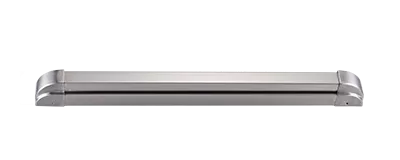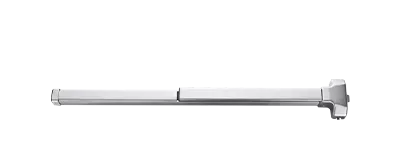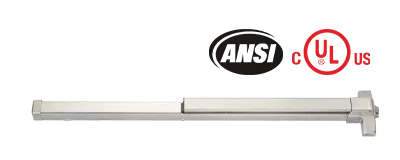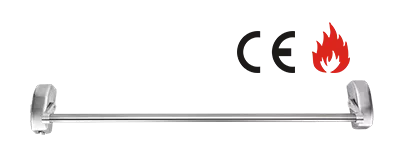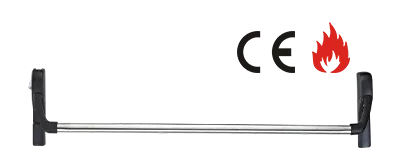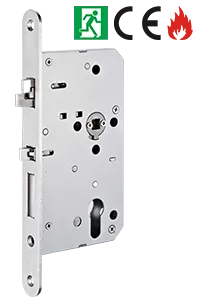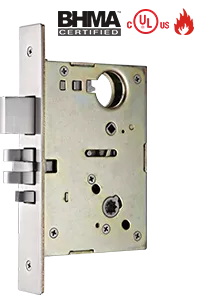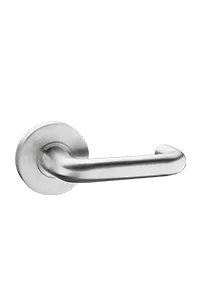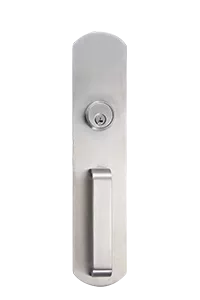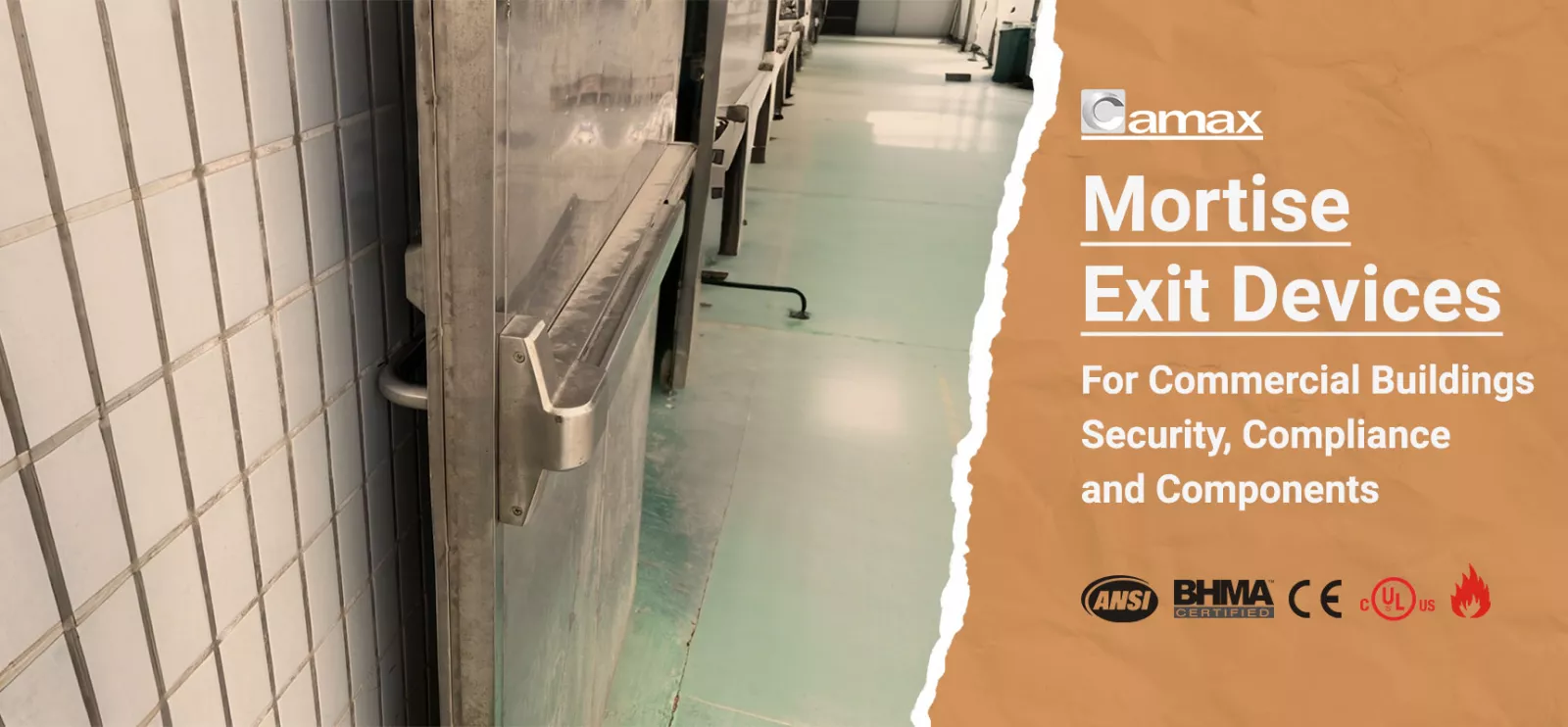
When it comes to building safety and security, exit devices play a crucial role in ensuring quick and efficient egress during emergencies. Among the various types of exit devices available, mortise exit devices stand out for their durability, reliability, and compliance with safety standards. Whether you’re managing a commercial building, school, hospital, or hotel, understanding mortise exit devices is essential for making informed decisions about your building’s safety infrastructure.
In this article, we’ll explore what mortise exit devices are, how they work, the different types available, and how to choose the right one for your needs. We’ll also present the related door hardware for mortise lock exit devices.
Table of contents
What Is a Mortise Exit Device?
A mortise exit device is a type of emergency exit door locks designed to provide safe and quick egress during emergencies. It is installed within a mortise (a recess) in the door’s edge, making it a discreet yet highly functional solution. Mortise exit devices are commonly used in commercial and public buildings where safety and compliance with building codes are paramount.
Mortise exit devices are widely used in various commercial and institutional settings due to their security, durability, and compliance with safety standards.
In commercial buildings such as offices, malls, and retail stores, they provide both reliable security and a sleek, professional appearance.
Schools and universities depend on these devices to ensure safe egress while meeting strict building codes.
In hospitals and healthcare facilities, quick and easy exit solutions are crucial for patient and staff safety.
Industrial environments, including factories, warehouses, and data centers, also require robust exit hardware that can withstand heavy use while maintaining security and accessibility.
How Does a Mortise Exit Device Work?
A mortise exit device is designed to provide a secure yet easily operable exit solution. From the interior side of the door, occupants simply press the push bar or panic bar, which immediately retracts the latch, allowing the door to open effortlessly. This ensures quick and safe egress, especially in emergency situations.
On the exterior side, access is controlled using a keyed lock or trim hardware such as a lever or pull handle. This setup allows authorized personnel to lock or unlock the door as needed while maintaining restricted entry from the outside for security purposes.
The mechanism of a mortise lock exit device is designed for both security and ease of egress, consisting of three key components that work together seamlessly:
Mortise Lock Body: This is embedded within the door and contains the internal locking components, ensuring a secure and concealed mechanism that is more resistant to tampering compared to surface-mounted alternatives.
Latch Mechanism: The latch engages with the door frame, keeping the door securely locked until the exit device is activated. Some models feature anti-latch retraction for added security.
Exit Bar (Push Bar): When pressed, the mechanism retracts the latch instantly, allowing quick and effortless exit during an emergency.
What Are The Related Door Hardware Components for A Mortise Exit Device?
A mortise exit device is part of a larger door hardware system, requiring several key components to ensure smooth operation, security, and compliance with safety regulations. The most important related hardware includes exit devices, mortise locks, and trims, each playing a crucial role in the functionality of the overall system.
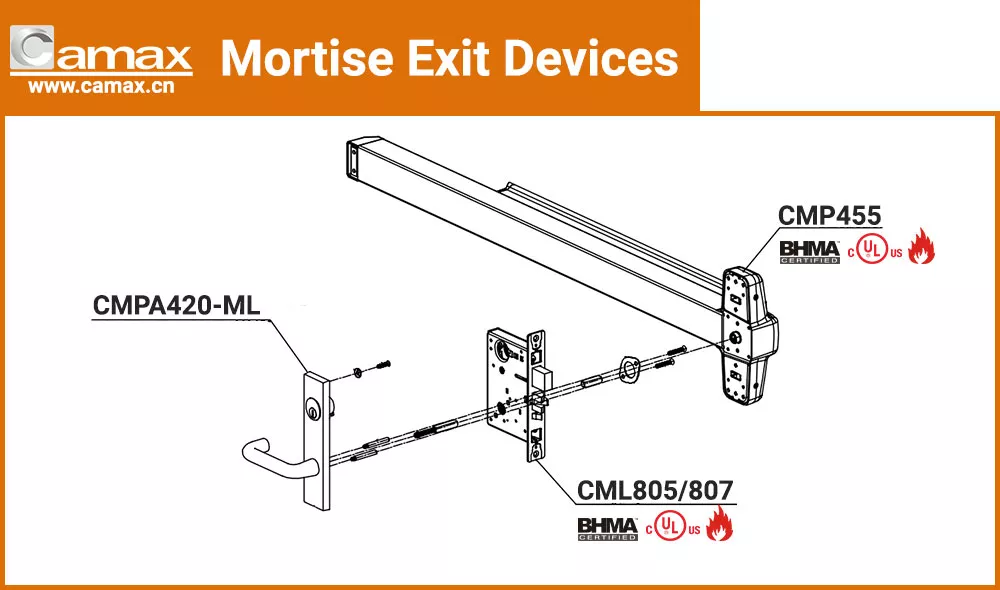
1. Exit Devices
Exit devices are the core component, providing an easy and efficient way for occupants to exit a building by simply pressing the push bar. These devices are essential for emergency egress, ensuring doors can be opened quickly while maintaining security from the exterior.
Camax Hardware manufactures high-quality panic exit devices designed for seamless integration with both ANSI mortise locks and EURO mortise locks. These exit devices provide reliable security while ensuring quick and effortless egress in emergency situations. Built to meet industry standards, they are ideal for commercial buildings, schools, hospitals, and other high-traffic areas. Whether paired with ANSI mortise locks, commonly used in North America, or EURO mortise locks, popular in European and international markets, Camax Hardware’s panic exit devices offer versatile compatibility, durability, and ease of installation, making them a trusted choice for architects, contractors, and security professionals worldwide.
- • Touch bar for mortise lock
- • Non-handed
- • Compliance: EN1125, EN1634-1 fire rated; ANSI/BHMA A156.3 grade 1, UL fire rated
- • Material: Stainless steel, Steel
- • Finish: Stainless steel satin, Silver painted, Polishing, PVD, Black, Red
- • CE & UL Listed Panic Touch Bar
- • Non-handed
- • Certificate: ANSI/BHMA A156.3 grade 1; UL10C, fire rated
- • Material: Stainless steel, Steel
- • Finish: Stainless steel satin, Silver painted, Polishing, PVD, Black, Red
2. Mortise Locks
Mortise locks are embedded within the door and work in conjunction with the exit device to provide a secure locking mechanism. Unlike surface-mounted locks, mortise locks offer enhanced durability and a more seamless appearance, making them ideal for high-traffic commercial and institutional settings.
Camax Hardware specializes in manufacturing high-quality mortise locks designed for panic exit devices, ensuring full compliance with both ANSI (American National Standards Institute) and EURO (European) safety standards. These durable and reliable locks are engineered to provide secure and efficient egress during emergencies, making them ideal for commercial, public, and high-traffic environments where safety and compliance are paramount.
- • ANSI Commercial Mortise Locks
- • Certificate: BHMA listed; ANSI/BHMA A156.13-2020, Grade 1 (1,000,000); UL10C fire rated, 3 hours
- • Multi functions in one case
- • Field-reversible handing without opening lock case
- • Automatic Deadbolt Locking Exit Lock
- • Compliance with: EN12209; EN179; EN1125
- • Lock case seal, zinc plated
- • Non-handed
- • Bolt projection, one throw
- • Latch & Bolt: Stainless steel 304
3. Trims
Trims refer to the exterior components, such as lever handles, knobs, or pull handles, which control access from the outside. These trims allow authorized personnel to unlock or lock the door as needed while keeping it secured against unauthorized entry.
Camax Hardware provides a diverse range of trims for mortise exit devices, crafted to suit both functional and aesthetic preferences. In this section, we’ll highlight 4 standout trims for ANSI mortise exit devices that combine durability, style, and user-friendly features, helping you find the perfect match for your commercial or institutional needs.
- • Escutcheon Trim
- • Non-handed
- • Lever is controlled by mortise lock. Key retracts latch of mortise lock.
- • Door thickness 44-50mm
- • Material: Stainless steel, steel
- • Finish: Stainless steel, Silver painted, Polishing, PVD, Black, Red
- • Pull & Thumbpiece Trim
- • Cylinder directly drives the mortise lock
- • Non-handed
- • Trim has through-bolts to the device chassis for more security and durability. It fits 1-3/4" (44mm) doors.
- • Finish: US3, US4, US10, US10B, US26, US26B and US32D
- • Lever for ANSI Mortise Lock
- • Material: Stainless Steel
- • Finish: Stain finish, Polishing, PVD
How to Choose the Right Mortise Exit Device
When choosing a mortise panic exit device, it’s important to consider a variety of factors to ensure it meets both functional and regulatory requirements.
First and foremost, the device must comply with local building codes and safety standards, including ANSI (American National Standards Institute) and NFPA (National Fire Protection Association) requirements. This guarantees that the device meets safety and security regulations for emergency egress and fire safety, providing peace of mind for both occupants and building owners.
Selecting the right size, finish, and function is equally crucial. The size of the device should be appropriate for the door’s thickness and dimensions to ensure a secure fit and reliable operation. The finish of the exit device should complement the door’s design, whether it’s stainless steel, brass, or black, helping to maintain the aesthetic appeal of the building. Additionally, you’ll need to choose between mechanical or electrified options, depending on your specific security needs.
Mortise exit devices are highly versatile and can be used on a range of door materials, including wood, metal, and glass. However, compatibility with the door material is key to ensuring smooth operation and durability. For even greater security, consider models that are compatible with access control systems or electronic locks, providing advanced features for restricted access areas.
Contact Camax Hardware for More Information about Mortise Exit Devices
Mortise exit devices are an essential component of secure and code-compliant exit solutions. They offer a blend of durability, security, and aesthetic appeal, making them ideal for commercial, institutional, and industrial applications. Whether you need a fire-rated model, an electrified option, or a solution that integrates with access control, choosing the right mortise exit device is crucial for safety and compliance.
At Camax Hardware, we offer high-quality mortise exit devices that meet industry standards, including UL, CE, and BHMA certifications. Our experts can help you select the right model for your project and provide guidance on installation and compliance.
Contact Camax Hardware today to learn more about our mortise exit devices and how we can help you enhance the safety and security of your facility!
Need help? Contact Camax for a quote!
Discover Camax's door & window hardware with ANSI/BHMA/UL/CE certification today!



